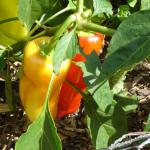Growing Capsicum, also Bell peppers, Sweet peppers
Capsicum annuum : Solanaceae / the nightshade family
| Jan | Feb | Mar | Apr | May | Jun | Jul | Aug | Sep | Oct | Nov | Dec |
|---|---|---|---|---|---|---|---|---|---|---|---|
| S | S | ||||||||||
| T | T | ||||||||||
| P | P |
(Best months for growing Capsicum in USA - Zone 5a regions)
- S = Plant undercover in seed trays
- T = Plant out (transplant) seedlings
- P = Sow seed
- Grow in seed trays, and plant out in 4-6 weeks. Sow seed at a depth approximately three times the diameter of the seed. Best planted at soil temperatures between 64°F and 95°F.
- Space plants: 8 - 20 inches apart
- Harvest in 10-12 weeks. Cut fruit off with sharp knife.
- Compatible with (can grow beside): Egg plant (Aubergine), Nasturtiums, Basil, Parsley, Amaranth
Small bushy plant about 40cm high. The seeds are reluctant to start germinating if temperatures drop at night. These are best sown in small trays in a warm, sheltered place: a small greenhouse if possible. Plant out when about 10 -12cm (4-5in) tall.
They are from the same family as chilli but are not hot and spicy. The seeds and white flesh are bitter.
Capsicums are frost tender and need warmth to ripen the fruit to the brilliant reds and yellows of commercial ones. They can be used green but are not as sweet.
There are a number of colours available, chocolate, black, yellow, orange as well as red. They all start off green and change as they ripen.
In cool, wet weather cover with a cloche or frost fleece.
Culinary hints - cooking and eating Capsicum
Can be sliced and seeded and used raw in salads.
Will freeze successfully without blanching if seeded and sliced.
Brush with olive oil, roast at a high temperature until the skin changes colour then put in a covered dish until cool and rub off the skin and remove seeds.



Your comments and tips